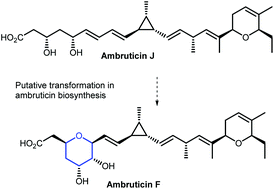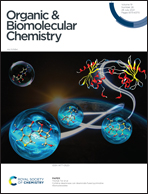Ambruticins: tetrahydropyran ring formation and total synthesis†
Abstract
The ambruticins are a family of polyketide natural products which exhibit potent antifungal activity. Gene knockout experiments are in accord with the proposal that the tetrahydropyran ring of the ambruticins is formed via the AmbJ catalysed epoxidation of the unsaturated 3,5-dihydroxy acid, ambruticin J, followed by regioselective cyclisation to ambruticin F. Herein, a convergent approach to the total synthesis of ambruticin J is described as well as model studies involving epoxidation and cyclisations of unsaturated hydroxy esters to give tetrahydropyrans and tetrahydrofurans. The total synthesis involves preparation of three key fragments which were united via a Suzuki–Miyaura cross-coupling and Julia–Kocienski olefination to generate the required carbon framework. Global deprotection to a triol and selective oxidation of the primary alcohol gave, after hydrolysis of the lactone, ambruticin J.

- This article is part of the themed collection: Total synthesis in OBC


 Please wait while we load your content...
Please wait while we load your content...